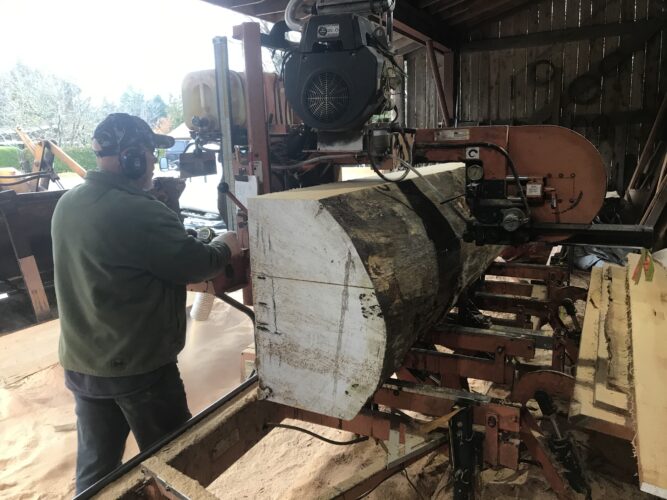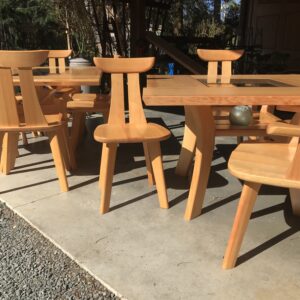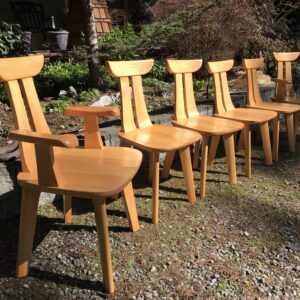About Saratoga Woodworks
Woodworking has been in me since I was a child. Growing up in rural Campbell River I always had a keen interest in designing and building things from wood. As I got older woodworking developed into a serious hobby and as I moved forward, I explored design and function to create useful and long-lived practical pieces. Along the way, I was mentored by some experienced craftsmen and I began to explore many different styles and genres eventually finding inspiration in the Arts & Crafts movement.
I have nurtured the Craftsman philosophy utilizing locally sourced materials, then crafting with respect for this valuable resource.
My passion for local woods began early in my career in the forest industry. In my work up and down the coast I often found myself in awe of the magnificent trees we have on this coast. This appreciation for these stunning trees in their natural habitat provides the inspiration for each piece of wood that goes into my furniture.
Designing and building our first home led me to my first significant project of engineering and building all the doors and windows for the home. For the next 20 years doors and windows would be the focus of my woodworking business all the while dabbling with furniture. As I developed my design skills, I also refined my workmanship and attention to detail.
I have now focused solely on custom stand alone furniture projects such as benches , chairs, tables consoles ect. Clients often collaborate with me for that made to fit piece. My furniture is crafted from Plain and Figured Maple, Yew, Douglas Fir and Cherry along with what ever local gems I've been able to reclaim along the way.
My passion is using traditional joinery to produce quality pieces, while exploring new designs, skills and methods in an ever evolving learning curve.
Designing and creating custom one of a kind furniture is a very enjoyable and rewarding journey for both me and the client as we create something that transcends ages.
Sharing my passion, knowledge and skills with others is the biggest reward for me.
Every tree has a story to tell...
These 2 first growth Douglas fir trees were harvested from a wood lot in Nootka Sound.


They were destined for the overseas markets. Local contacts put me in touch with the broker and I found out some of the logs were deemed not the quality the overseas buyers were looking for. After viewing about 10 specimens, I made the choice to purchase 2 of what I called “quality “logs. These logs are 42’ long and have an average diameter of 49”. I had a local trucker deliver them to my neighborhood sawmill. Together we were able to recover lots of fine grain fir among the defects. Having this resource in my possession has enabled me to build numerous doors, windows and custom entryways in the time since purchasing them a few years ago.
I am very selective with the projects I chose to build with this valuable wood. The evolution of my woodwork, has always been working toward handcrafted "fine furniture".
These recently completed dining sets in Douglas Fir are the culmination of the years of dedication to the woodworking craft.
With big fir logs, the premium cut is called “edge or vertical grain “,that is milling with the growth rings perpendicular to the wide surface of the board. This “cut” produces the most stable, large piece of lumber. It also reveals the climatic history of the tree in its given geographical location.
The boards selected for the table tops are about 14” wide and represent about 3-400 years. I have casually studied the growth rings in these boards and have discovered some interesting details. The outer edge of the table represents the outside of the tree and is darker in colour and has somewhat larger rings ,which is non typical for such a tree. I have a probable explanation...Growth rings in fir have 2 parts...summer,light colour and winter growth,dark colour...due in part to the mineral uptake of the tree from the soils in winter.
Typically, a fir tree produces light coloured blonde wood and then, from the centre, it ages to the classic fir amber/orange. The dark colour and big rings on the outside edge could be the result of the selective harvesting in Nootka Sound at the turn of the 20th century. At this time, these trees were probably deemed not up to the harvesting standard of the day, so they were left standing, to grow another 100 years to their harvest. The dark, wide grain of these boards could be the result of these trees getting all the sun, nutrients and minerals that were previously available to the complete forest. One can see how the climate has varied over time, showing very slow growth at times and very robust growth in other times. Counting the growth rings can also connect historical and climatic timelines for Nootka Sound these trees were harvested in 2017 the outside edge of the top is close to representing the year 2000.







